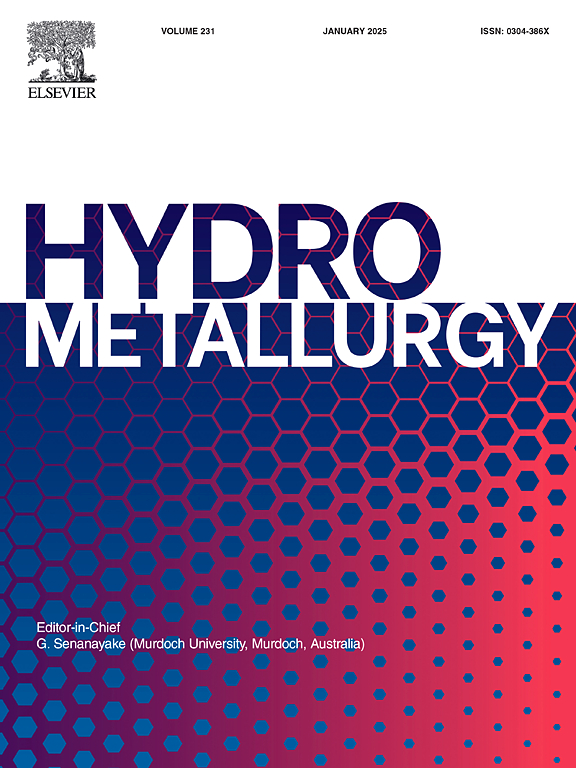Process intensification in precipitation of uranium from post alkali leach liquor using re-dissolution of sodium diuranate slurry: A short review of laboratory and pilot scale test results
IF 4.8
2区 材料科学
Q1 METALLURGY & METALLURGICAL ENGINEERING
引用次数: 0
Abstract
The Uranium Corporation of India Limited (UCIL) Tummalapalle facility processes a low-grade uranium ore (0.042 % U3O8), necessitating the enhancement of low uranium concentration (0.74 g/L U3O8) in the clarified leach liquor as a critical goal for process optimization in the precipitation stage. Enhanced concentration of U3O8 in the process liquor is pivotal for maximizing the recovery of the final uranium product. Various filtration technologies were evaluated at laboratory and pilot scales to recover ultra-fine sodium diuranate (SDU) particles to improve recovery. These technologies included candle filters, ceramic filters, cartridge filters, and ultrafiltration. However, none of these methods proved viable for a sustained operation under plant conditions. Additional techniques such as ion exchange, centrifugation, and nanofiltration were also assessed but failed due to inherent technical constraints. Experimental results from laboratory and pilot scale tests indicated that precipitation at approximately 2.5 g/L U3O8 in the leach liquor yielded a product with optimal settling characteristics and minimized uranium losses, both in unprecipitated and precipitated forms. In order to achieve this target and enhance precipitation efficiency, a bleed stream of the sodium diuranate slurry from the precipitation circuit was combined with clarified low grade leach liquor to redissolve SDU and heated to approximately 75–80 °C to prepare a concentrated solution of 2.5 g/L. This approach significantly improved the precipitation efficiency of the process liquor in the low-grade ore processing unit.
用重铀酸钠浆料再溶解法从碱浸液中沉淀铀的工艺强化:实验室和中试试验结果的简要回顾
印度铀公司(UCIL) Tummalapalle设施处理低品位铀矿石(0.042% U3O8),需要在澄清浸出液中提高低铀浓度(0.74 g/L U3O8),作为沉淀阶段工艺优化的关键目标。提高工艺液中U3O8的浓度是提高最终铀产品回收率的关键。在实验室和中试规模上对各种过滤技术进行了评估,以回收超细双铀酸钠(SDU)颗粒,以提高回收率。这些技术包括蜡烛过滤器、陶瓷过滤器、滤筒过滤器和超滤。然而,这些方法都不适合在工厂条件下持续运行。其他技术如离子交换、离心和纳滤也进行了评估,但由于固有的技术限制而失败。实验室和中试规模试验的实验结果表明,浸出液中约2.5 g/L的U3O8沉淀产生的产品具有最佳的沉降特性,并且以非沉淀和沉淀形式将铀损失降至最低。为了达到这一目标并提高沉淀效率,从沉淀回路中排出的二铀酸钠浆液与澄清后的低品位浸出液结合,将SDU再溶解,加热至75 ~ 80℃左右,得到2.5 g/L的浓溶液。该方法显著提高了低品位矿石处理装置工艺液的沉淀效率。
本文章由计算机程序翻译,如有差异,请以英文原文为准。
求助全文
约1分钟内获得全文
求助全文
来源期刊

Hydrometallurgy
工程技术-冶金工程
CiteScore
9.50
自引率
6.40%
发文量
144
审稿时长
3.4 months
期刊介绍:
Hydrometallurgy aims to compile studies on novel processes, process design, chemistry, modelling, control, economics and interfaces between unit operations, and to provide a forum for discussions on case histories and operational difficulties.
Topics covered include: leaching of metal values by chemical reagents or bacterial action at ambient or elevated pressures and temperatures; separation of solids from leach liquors; removal of impurities and recovery of metal values by precipitation, ion exchange, solvent extraction, gaseous reduction, cementation, electro-winning and electro-refining; pre-treatment of ores by roasting or chemical treatments such as halogenation or reduction; recycling of reagents and treatment of effluents.
 求助内容:
求助内容: 应助结果提醒方式:
应助结果提醒方式:


